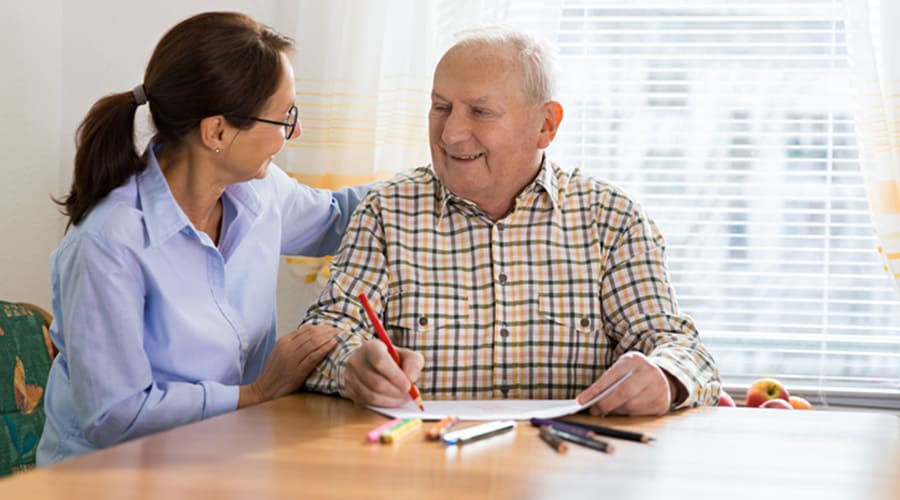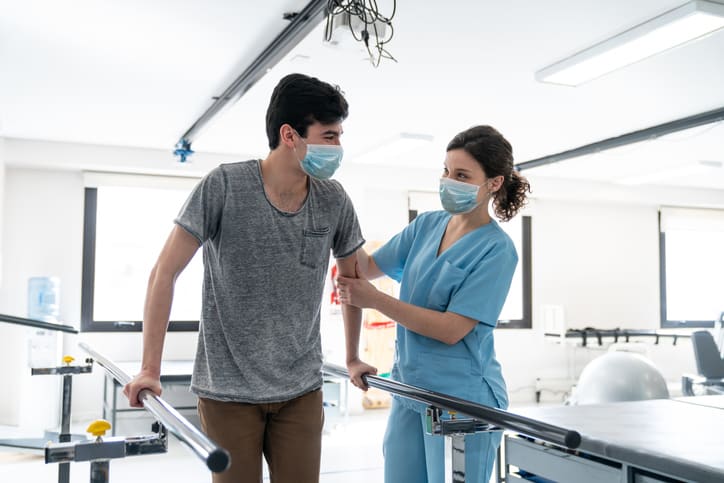Falls are the leading cause of death and injury among older adults in the United States (U.S.). According to the Centers for Disease Control (CDC), one out of four adults 65 and older will fall annually in the U.S. Factors contributing to falls in older adults include age-related changes in vision, balance, muscle strength, and cognitive function, as well as environmental hazards and medical conditions.
Occupational therapy serves as a cornerstone in fall prevention strategies, emphasizing the importance of holistic, client-centered approaches to enhance older adults’ safety, well-being, and independence. Occupational therapists do not just address interventions but also strategies for prevention of falls in older adults.
Related: Promoting Patient Safety: A Focus on Falls Prevention

Assessing falls in older adults
Occupational therapists conduct thorough evaluations that include non-standardized and standardized assessments to identify individual fall risks and tailor interventions accordingly. Assessments encompass physical, cognitive, sensory, and environmental factors that can contribute to falls.
Non-standardized assessments include:
- Client interviews about fall history and home setup
- Clinical observations of functional performance
- Informal home assessments
Standardized assessments include:
- Grip strength with a dynamometer. Grip strength correlates with overall health and fall risk. Grip strength peaks between 30 and 40 before declining, so a decreased grip strength reading for older adults is expected. As strength declines, healthcare providers can still evaluate a client’s grip strength to determine how it compares to the normative data for that client’s age group. This will provide data that accounts for an age-related decline.
- Functional Reach Test. The Functional Reach Test (FRT) is a widely used clinical assessment tool employed by occupational therapists to evaluate an individual’s dynamic balance and functional mobility. During the test, the individual stands in a comfortable upright position with their arm extended forward at shoulder height, parallel to the ground, and perpendicular to their body. Without losing balance or taking a step, the individual reaches forward as far as possible, and the distance between the starting position and the endpoint is measured.
The FRT provides valuable insights into an individual’s ability to maintain stability while performing a reaching task, reflecting their risk of falls and functional limitations. Occupational therapists utilize FRT results to inform fall prevention interventions, exercise programs, and environmental modifications tailored to enhance balance, functional mobility, and overall independence in daily activities.
Related: Supporting Aging in Place: An Occupational Therapist’s Toolkit
Environmental modifications and adaptive equipment
A 2021 research study published in the American Journal of Lifestyle Medicine cites homes as the most common place for falls for older adults. The most common locations for a fall at home were the bedroom, bathroom, and stairs. Occupational therapists can make environmental modifications for the home and adaptive equipment for engagement in activities of daily (ADLs) in the home.
Environmental modifications and recommendations include:
- Remove throw rugs
- Remove clutter from walkways
- Ensure adequate lighting
Adaptive equipment can include:
- Use a non-skid mat in the shower
- Use of grab bars in the showers to assist with transfers
- Use of shower chairs for sitting during showering and eliminating the need to sit in the tub
- Raised toilet seats with handles
- Reachers to reduce the need to bend to the floor
Fall recovery practice
Practicing fall recovery techniques is an important fall prevention strategy for older adults. Fall recovery involves learning and practicing specific movements and strategies to minimize the impact of a fall and reduce the risk of injury. Fall recovery also focuses on getting up with modified independence to minimal assistance after a fall.
Therapeutic exercises
A 2021 article published in Advances in Geriatric Medicine and Research cites the physical benefits of yoga for older adults to decrease fall risk. Some of these benefits are:
- Increased mobility
- Protection against cognitive decline
- Increased flexibility
- Increased strength
- Increased balance
Therapeutic exercises also include core exercises and upper body strengthening.
Function-based treatments
Function-based treatments are supported by research and emphasized in the Choosing Wisely® initiatives of the American Occupational Therapy Association (AOTA). Therapeutic programs should be tailored to clients’ unique needs, strengths, and desired outcomes.
The first tenet of AOTA’s Choosing Wisely initiative states: “Don’t provide intervention activities that are non-purposeful.” Purposeful interventions include having the client complete the functional activities to increase balance, core strength, and activity tolerance for a decreased fall risk. Functional activities include:
- Grocery shopping
- Laundry
- Yardwork
- Cooking
- Cleaning
- Showering
- Pet care
Function-based treatments that use purposeful activities have many benefits, such as:
- Increasing patient engagement
- Facilitating dynamic movements that recruit the supporting muscles
- Increasing endurance
- Improving overall motor performance
Preventing falls in older adults
With falls being the leading cause of death and injury in this population, occupational therapists utilize a holistic, client-centered approach to prevent falls and enhance safety, well-being, and independence. Through comprehensive fall assessments, environmental modifications, adaptive equipment recommendations, fall recovery practice, therapeutic exercises, and function-based treatments, occupational therapists strive to minimize fall risks. They empower older adults to engage in meaningful activities of daily living with confidence and autonomy. By integrating evidence-based interventions and promoting purposeful activities, occupational therapists contribute to improving the overall quality of life for older adults and fostering healthy aging within communities.





